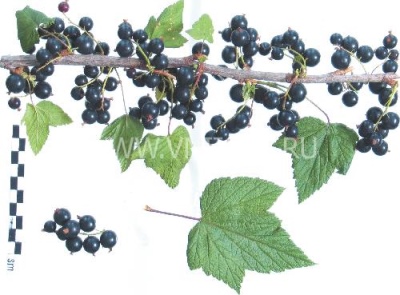
- Authors: Bayanova L.V., Ogoltsova T.P., Knyazev S.D. (FGBNU All-Russian Research Institute of Selection of Fruit Crops)
- Appeared when crossing: Bummer x Ruffle
- Year of approval: 2001
- Ripening terms: average ripening
- Growth type: medium-sized
- Yield: high
- Appointment: universal
- Berry weight, g: 1,4
- Tasting assessment: 4,5
- Escapes: thick, straight, green
Openwork currant variety - already sounds beautiful. But it is all the more important to understand that this plant will need careful care and attention. And you need to know what exactly to do in this case.
Breeding history
This plant was created at the All-Russian Research Institute of Breeding of Fruit Crops. The project was supervised by breeders Bayanova, Ogoltsova and Knyazev. The biological material of the Ershistaya and Lazytay varieties was taken as a basis. The culture was entered into the State Register of the Russian Federation in 2001.
Description of the variety
Openwork is one of the black currants. This plant has a universal purpose. Medium-sized bushes are moderately spreading and have thick green shoots. The five-lobed dark green leaf is quite large. Moderately large flowers are painted in bright colors. A medium sized brush with dense fruit cover and a medium straight spine.
Characteristics of berries
They grow to a very large size and stand out for their rich black color. Other parameters:
average weight 1.4 g;
transition from a circle to an oval shape;
moderately thick rind;
dry separation;
average number of seeds.
Taste qualities
This variety has a sweet and sour taste. The berries contain an average of 7.9% sugar. The share of acids is 3.3%, which is already quite a lot. It is worth noting the high concentration of ascorbic acid. A small amount of seeds is unlikely to significantly affect the perception of the fruit, and the usual tasting score is 4.5 points.
Ripening and fruiting
Openwork - culture with an average ripening period. She begins to bear fruit approximately in the third decade of July. At the same time, which is important, early maturity is normally guaranteed. But much depends on the moments already known to all gardeners.

Yield
Such currants are highly productive. It can produce 74.6 centners of berries per hectare. And also in the official description the highest achievable productivity of 110 centners per hectare is mentioned. For one bush, this figure will be 1.6 kg.
Growing regions
The plant is zoned for:
Central Black Earth Region;
the center of the European part of Russia;
Volga-Vyatka region.
Self-fertility and the need for pollinators
Openwork is not just self-fertile. She is highly self-fertile. Therefore, it is quite possible to grow this culture without the help of additional varieties. The self-fertility rate is declared at 59%.
Landing
Autumn planting for this variety is best suited. Such a moment is especially important for regions where it is warm for a long time in autumn.The spring planting must be completed before the juices begin to move and the buds swell. Openwork currant does not like lowlands. It is important to make sure that the soil is fertile, has a neutral or slightly acidic reaction.
14-20 days before the start of work, the earth is dug into the depth of the shovel bayonet. At the same time, fertilizers are also laid:
superphosphate;
humus;
wood ash.

Growing and care
Trimming the Openwork Currant should be done before the buds have time to swell. All of them that are affected by the tick are also removed. With a large lesion of the kidneys, the branches are cut to the base. You can simplify weeding by laying out mulch. Its best option is humus or manure.
Water the currants systematically and with plenty of water. Having irrigated it, the soil is loosened. You can loosen the soil even through mulch. When spring comes, the bushes are fed with complex fertilizers based on nitrogen. If a large number of ovaries are formed, and the branches begin to bend under the weight of the berries, you will have to put up supports.




Disease and pest resistance
Declared resistance to:
powdery mildew;
anthracnose;
septoria;
columnar rust;
kidney mites (which does not mean the ability to ignore preventive treatments for these and other dangerous factors).

Currant is one of the most favorite crops of gardeners, it can be found on almost any personal plot. In order for the currant berries to be tasty and large, and the bush itself to be healthy and strong, you should properly care for, treat and protect the plant from harmful insects. It is important to recognize the signs of the disease in a timely manner and begin treatment in the early stages of plant damage.
Resistance to adverse climatic conditions
Winter hardiness of this black currant is very high. At the same time, she still needs to choose sunny places. But it is necessary to check whether the plantings will not be affected by cold winds. With the likelihood of a cold winter, shelter of at least young seedlings is mandatory.










































































